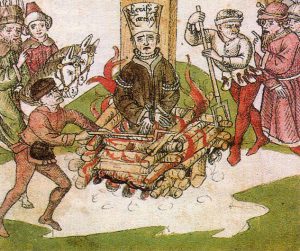Jan Žižka
By Erin Naillon
Jan Žižka is one of the most famous of all generals in Czech history. He made a name for himself during the uprising in the aftermath of Jan Hus’ execution and continued as a brilliant military commander in the Hussite Wars.
Early Years
Žižka was born in the small village of Trocnov. As a young man, he became a member of the royal court of Bohemia, acting as chamberlain to the Queen. Fairly early in his life, he lost one eye, either by accident or by malice; the true cause is not known.
Battle
At the age of around fifty (the exact year of his birth is unknown), Žižka commanded troops at the Battle of Grunwald. The Teutonic Knights were the enemy, and they were soundly defeated. Furthermore, they never again reached the same power they had enjoyed before the battle.
 Jan Hus
Jan Hus
Just a few years later, the Czech reformer Jan Hus was burned at the stake in Constance. Žižka, a firm believer in Hus’ cause, took the side of the Hussites against Emperor Sigismund and acted decisively in the First Defenestration of Prague. Disagreeing with the other Hussites on an armistice, Žižka took his followers first to Pilsen, then to South Bohemia, where they moved into the new city of Tábor.
Tábor
The community was run along military lines, with Žižka acting as one of the four officials. The area was mostly a farming community, and Žižka wisely turned farming implements into battle tools. Cannons were mounted on wagons as an early tank prototype. Žižka used carts to draw enemy fire in the first stage of battle; each cart contained 16 to 22 soldiers of various types. Žižka was well-versed in warfare, and he used new weapons – the pistol and the cannon – that required a new material, gunpowder.
The carts, which were close to enemy forces, fired relentlessly upon the troops until the enemy attacked. It was then that more soldiers – hidden behind the carts, where the other side couldn’t see them – let loose with a barrage of arrows and bullets.
With the enemy now lacking many horses (who had been shot from under their riders, many of whom died from the fall) and many men, Žižka’s forces attacked on foot and from horseback. The Hussites took no prisoners.
Crusades
The citizens of Prague called upon Žižka to help them when Sigismund’s forces were threatening the city during the first anti-Hussite crusade. Žižka and his forces set up a position on a hill outside the city limits, where they successfully repelled Sigismund’s attack. So successful was the defense that Žižka and the soldiers left Prague on August 22. Later fighting freed the rest of Bohemia from Sigismund’s grip. In 1421, Žižka was badly wounded in battle and lost his other eye. Despite being completely blind, he continued to direct military operations.
That same year, Žižka surrounded the city of Kutná Hora, which had been seized by Sigismund. He and his men camped outside the walls of the city, only to be surrounded themselves. Žižka, though blind, brought his men through the enemy lines, retreating to the city of Kolín. He then attacked Sigismund’s army in January of 1422, killing 12,000 of the troops and almost killing the Emperor himself, who fled. Four days later, at the Battle of Německý Brod, Žižka defeated more of Sigismund’s troops.
Infighting
Internal strife had led to violence among the Hussites, and Žižka was now called upon to defeat the Utraquists. He did so at Strachov (near Hradec Králové) on August 4, 1423. The following year, on January 6 and June 7, he defeated them again. When peace was declared between the warring factions, an agreement was made that Žižka should be the leader of a military campaign to attack Sigismund’s followers in Moravia.
Death
Žižka never did see this plan come to fruition. On October 11, 1424, he died of the plague near the Moravian border. His followers soon called themselves “Sirotci” (Orphans), since Žižka had been such a strong and powerful leader. It is said that he never lost a battle.
Legacy
Vítkov Hill, where Žižka successfully fought Sigismund’s army, is now part of the Prague 3 city district. This district is named Žižkov, in his honor. The hill showcases the world’s largest equestrian statue – of Žižka, naturally.



